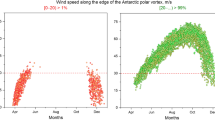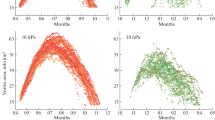Abstract
The dynamic barrier is one of the physical characteristics of the polar vortices; it prevents subpolar air masses from penetrating into the vortex and contributes to a temperature decrease inside the vortex in the lower stratosphere. In the presence of a dynamic barrier in winter, chlorine cycle reagents of ozone destruction accumulate on particles of polar stratospheric clouds (PSCs) and heterogeneous reactions occur with the formation of molecular chlorine. Solar radiation over the polar region trigger photochemical reactions that lead to large-scale ozone depletion. When the dynamic barrier weakens in winter, the temperature inside the vortex rises, PSC particles are destroyed, and, thus, the accumulation of chlorine cycle reagents on PSCs is interrupted. The dynamics of the Arctic polar vortex is proposed to be divided into three types according to the character of consequences: (1) a strong vortex, the activity of which results in the formation of an ozone anomaly, (2) a weak vortex with breakdown in winter, marked by a sudden stratospheric warming, and (3) a stable vortex with an episode (episodes) of weakening of the dynamic barrier in winter without ozone depletion in the period from late winter to spring. A characteristic of the dynamic barrier of the polar vortex at all pressure levels from 100 to 1 hPa is presented for the first time and the consequences of its weakening are described. Using the vortex delineation method based on the data of the ERA5 and MERRA-2 re-analyses, it is shown that in all cases when the polar ozone anomaly was not recorded from late winter to spring under the conditions of the stable polar vortex, the dynamic barrier weakened and particles in the PSСs were destroyed in midwinter.







Similar content being viewed by others
REFERENCES
D. W. Waugh, A. H. Sobel, and L. M. Polvani, Bull. Am. Meteorol. Soc. 98 (1), 37–44 (2017).
G. L. Manney, R. W. Zurek, A. O’Neill, and R. Swinbank, J. Atmos. Sci. 51 (20), 2973–2994 (1994).
V. V. Zuev and E. Savelieva, Polar Sci. 25, 100532 (2020).
S. Solomon, Rev. Geophys. 37 (3), 275–316 (1999).
B. J. Finlayson-Pitts and J. N. Pitts, Chemistry of the Upper and Lower Atmosphere: Theory, Experiments, and Applications (Acad. Press, 2000).
H. Hersbach, B. Bell, P. Berrisford, et al., Q. J. R. Meteorol. Soc. 146 (729), 1–51 (2020).
R. Gelaro, W. McCarty, M. J. Suárez, et al., J. Clim. 30 (14), 5419–5454 (2017).
V. V. Zuev and E. Savelieva, J. Earth Syst. Sci. 132 (1), 39 (2023).
V. Limpasuvan, D. W. J. Thompson, and D. L. Hartmann, J. Clim. 17 (13), 2584–2596 (2004).
K. Hoppel, R. Bevilacqua, G. Nedoluha, et al., J. Geophys. Res. 107 (20), 8262 (2002).
J. Kuttippurath and G. Nikulin, Atmos. Chem. Phys. 12 (17), 8115–8129 (2012).
V. V. Zuev and E. Savelieva, Pure Appl. Geophys. 179 (6–7), 2609–2616 (2022).
J. Holton, An Introduction to Dynamic Meteorology, 4th ed. (Acad. Press, 2004).
Funding
This work was supported by the Russian Science Foundation, grant no. 23-17-00273, https://rscf.ru/project/23-17-00273/.
Author information
Authors and Affiliations
Corresponding author
Ethics declarations
The authors of this work declare that they have no conflicts of interest.
Additional information
Translated by L. Mukhortova
Publisher’s Note.
Pleiades Publishing remains neutral with regard to jurisdictional claims in published maps and institutional affiliations.
Rights and permissions
About this article
Cite this article
Zuev, V.V., Savelieva, E.S., Maslennikova, E.A. et al. Consequences of Weakening the Dynamic Barrier of the Arctic Polar Vortex. Dokl. Earth Sc. 514, 401–409 (2024). https://doi.org/10.1134/S1028334X23602924
Received:
Revised:
Accepted:
Published:
Issue Date:
DOI: https://doi.org/10.1134/S1028334X23602924




